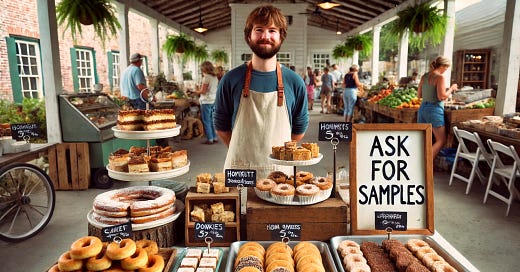My Best Sampling Recommendations
Protect Yourself and Your Booth with Common Sense Food Sampling
Greetings, fellow foodie!
PS Just a quick apology… Substack was down for a few days, and I got mad and took a reprieve from writing. I almost decided to find a new home for my newsletter... but their tech is SO delicious and easy for writers, I forgave them. I will now try and catch up with you over the next couple weeks.Today’s newsletter article is a follow-up to recent article on a two sampling horror stories from years past!
CATCH UP WITH THAT CONTENT HERE.
So, I am now going to give you my take on how to use Sampling for profit, while protecting yourself from human “pigs” and avoid turning your booth into an expensive mini-Costco browsing line.
Sampling of course, is one of your best tools for getting more sales at in-person events. Tickling someone’s taste buds is a great way (maybe the best way), to turn cold prospects into buyers, and eventually raving fans.
That is, assuming your goodies are delicious. And we both know they are! Kudos to you for your delicously hard work.
I sincerely feel for those of you living in a state where they make you package samples individually, and include sampling labels. Not sure my article will help in that case. But on the other hand, maybe the tips will make things more manageable. And less expensive.
We’ve seen a number of rule complaints in the Cottage Food Business Facebook community (two-year anniversary coming up next month!). Questions such as “do you really need to put ingredients on every sample?”
I’ve never run into that here in Idaho. Generally, there are few or no rules about cottage sampling here in the huckleberry state. But if they did tell me to do that ridiculous thing, I would just hang out a small sign with the ingredients.
(And if the sampler taster can’t read, too bad for them.)
Enough is a enough.
Anyway, here is my list of tips:
Keep your samples/sampling tray out of reach. (Leave a prominent sign “Samples Available” or “Ask for Samples” next to the goodies you are sampling.)
2. This means, they need to ask for a sample, so they need to really want it. So you reduce sampling waste, grubby hands, re-sampling, and sampling costs.
Use the “ask” to engage with them. Maybe do a little “consultative” selling as the goodie rolls over their tongue.
Make it easy to get a handle on the sample (once you get it within reach), e.g. toothpicks, mini-utensils, or even hand it to them on a mini-plate (be careful of sample sizes, and follow rules, to avoid falling out of cottage food regulations which might require a license or different category of license.)
Only sample one goodie at a time in your event. Accidents happen around sampling confusion. And serial samplers can divert you from paying customers.
Provide an advance sampling “schedule”. Browsers can sample a different goodie if they come back at different times of day (and/or more commonly at different shows.) For example, “We are sampling our chocolate goodie after lunch!” or even add signage. Next market (with calendar date), my mom’s famous cinnamon rolls! Following week (date), butterscotch chip oatmeal cookies (bring your own coffee!). Etc. Creating anticipation will keep ‘em looking forward and coming back! If you get requests, make the sampling schedule available in print. (Of course, that does require planning…but worth it!)
My last tip converts more browsers into buyers than any other single thing.
If someone comes in with children (minor children, ahem, not spouses posing), prepare for gold!
Whether mothers, aunties, or the occasional father, folks attending with whiny, drooling youngsters are your path to easy sales. And larger sales. But only if done correctly.
By now the kids are bored, and maybe acting out. They want to taste anything and everything with sugar. Especially chocolate.
And the adult parent or sitter is wearing down. If you can engage their charges for even a couple minutes, and keep them from tearing off arms, you become a god or goddess in the eyes of the person with the pocketbook.
This is your opportunity for presentation skills. If you are an elementary teacher, you know how to do this. If you are not, and maybe not even good with kids, let me give you a suggested sequence:
Salutation with adult.
Pull out the sampling tray (which is why a tray is a good idea.)
Wave it in front of the youngsters, but out of reach, adjusting speech a bit to their ages.
“I LOVE to share my goodies. Anyone here like to try… (chocolate, cookies, cupcakes, frosting, etc.)?” Beware of possible adult concerns about special diets.
When the hands go up, “Give me your first name, and then grab the goodie that looks most delicious!” And be prepared to say, “Just one for today,” when you get the inevitable question about quantity.
As they munch, ask for feedback. “Was that good?” You want the adult to hear the responses.
To adult: “Anything I can help you with today?”
Odds of a sale, quite good. And the more kids, the bigger the order.
Remember to be enthusiastically cordial, even in the absence of an order. And “Please come again soon! Thanks kids!”
If your appreciation is genuine, you will not believe the number of “boomerang” orders you get, after you thought it was a no.
One last tip about prospects dragging kids in tow. The rate of mini-disasters goes up, as the youngster is trying to be mature enough to handle his or her own goodie. Sometimes even after purchase with a full cookie or other yummy.
Another place where sincere graciousness pays off! (Practice and visualize, if you are not normally that way!)
The goodie breaks apart and hits the ground, or other calamity. Instantly, you are like “Oh, I am soooo sorry! Let me replace that for you!” And get them the new goodie. SNAP!
Mother will be embarrassed, maybe even aghast. So acting professionally will win tons of “brownie” points.
Sale maybe. Even probably. But regardless, you will be remembered. Sometimes the long game is the best game.
Blessings to your foodie enterprise!
Mal Dell
The MONETIZATION CHEF
Helping Foodies Cook Up Profits!








